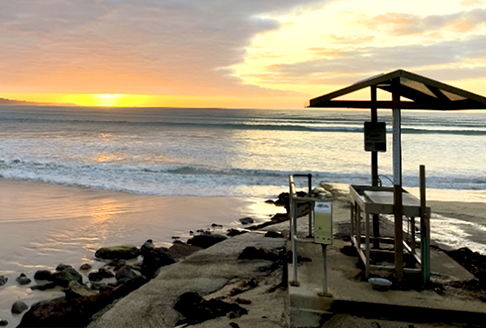Blue Christmas reflection by Acting Head of Spiritual Care, James Lewis
- 13 Dec 2023

In December 2013, our family packed into the car and drove the caravan across the Nullarbor for a long awaited Long Service Leave holiday. We planned to meet my sister and her family who live in Perth. Mum and Dad and my brother would fly over and join us for a wonderful Christmas gathering. But in July, Mum was diagnosed with a brain tumour. She died two months later. So the LSL changed from an exciting new adventure to a road trip with grief. Christmas was going to be different.
In Perth, we gathered with hearts full of love and eyes full of tears. Our dear Mum who had always been our dynamic social engineer was absent. But she was still powering us together! It was so sad, and yet so important to share together. We honoured our love for her in her absence, and in turn she made her ‘presence’ amongst us.
With Christmas upon us it is good to acknowledge that this can be a very difficult time for some people. Not everyone looks forward to Christmas: it is a season loaded with all kinds of baggage. It arrives with dreams of holiday excitement, end-of-year relief, family gatherings and parties. For many people it reminds us of those who we most dearly miss; a unique grief and sorrow. We may wish our Mum was still alive to share the time, or a child, or a partner. Equally we may wish to avoid having to spend time with difficult family members or carry the burden of expectations to spend money we don’t have on gifts. Christmas, tragically, is the worst time for domestic violence, homelessness and alcohol abuse.
In the northern hemisphere there is a tradition called ‘Blue Christmas’, held on 21 December, their Winter Solstice and longest night. Christian churches hold a service that makes space to honour people who have lost loved ones. The service includes expressions of grief and pain, as well as the opportunity to focus on the promise of hope found in Christ.
Acknowledging fragility in this season is important for addressing feelings of shame and isolation. It is helpful to talk about the tension between our hopes and ideals for Christmas – and the reality. A ‘Blue Christmas’ is one way of acknowledging our fragility in the face of difficult times. Sharing fragility builds a sense of common humanity – the gift of community, understanding and hope. Sometimes the heaviest burdens we carry are not imposed by others but by our own unrealistic expectations of ourselves.
This Christmas I hope you connect with trustworthy people who are safe, who nourish your life and soul with love, and who remind you of the beauty that emerges in vulnerability. May you have the courage to name what you need to care for yourself and your loved ones.
May you find solace and strength in places of beauty, in rituals and spiritual practices that bless your soul and spirit. May you find hope, peace and glimpses of goodness in the aspects of Christmas that feel safe and life-giving.
I believe God’s gift in Christmas is the promise of ‘Emmanuel’: God with us in our everyday journey. May there be a sense of the sacredness of companionship in your journey.
James Lewis
Acting Head of Spiritual Care.
Community news
-

Back to School Tips for Foster and Kinship Carers
Heading back to school can be exciting, but it can also bring up big feelings—especially for kids in care. Here are a few simple ways to help make the transition smoother.
- 17 Apr 2025
-

Easter Reflection from Emily Booth of our Spiritual Care Team
A few years ago, at Easter, I was staying with my sister and her family for the weekend. One afternoon we were all sitting around chatting and the kids were playing when my sister came into the room and placed a tray of fresh, warm hot cross buns on the table
- 16 Apr 2025
-

Student Volunteer Spotlight - Erin
Did you know that Baptcare has student volunteers at some of our Residential Aged Care communities? Our volunteers are an integral part of our Baptcare community, not only in residential aged care but across many of our programs and services. Volunteers provide essential connection, positivity and assistance to residents, clients and consumers.
- 04 Apr 2025
